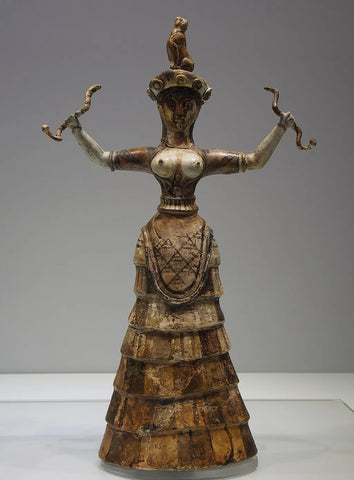TRIGGER WARNING: This article contains discussion about historical body standards.
For thousands of years, women have used shapewear to sculpt their bodies to achieve smooth, cinched, and socially desirable figures. But, from boobs-out-waist-in undergarments to heroin chic, to voluptuous BBL curves, and more, we've now entered into the era of Pinsy Shapewear. But how did we get to this point of fashion forward cute shapewear? How has shapewear changed through the centuries? Let's find out!
The earliest recorded version of shapewear belongs to Mycenaean Greece, when Minoan women donned corsets that pushed out their bare breasts and simultaneously brought in the waist.
 Minoan Figurine, c.1600 BCE
Minoan Figurine, c.1600 BCEIn Hellenic Greece, waist-cinching belts and girdles became fashion staples as an hourglass figure was seen as desirable. As metalwork became more advanced, metals like gold, silver, or copper were used to craft girdles.
Ancient Roman women wore cotton or linen chest binders to minimize their bosoms and emphasize their hips. Known as strophium, this chest band resembles today’s bandeau bra.
Roman Women Wearing Strophium,
Bikini Mosaic Villa Romana del Casale
Then, the shapewear industry took a major turn as tightly-laced bodices came into existence in the Medieval era. Let’s explore how shapewear has evolved since then:
The Middle Ages (5th to 15th Centuries) - Tightly Laced Bodice
An hourglass figure became more desirable in the Middle Ages than in the Medieval era, resulting in a new variety of shapewear. Tightly-laced bodices covered in paste helped women show off their curves and gave a scandalous peeks of the chemise beneath.
 However, tight binding on the chest and waist was incredibly restrictive, which made it difficult for women to breathe comfortably. So, this era of shapewear marked painful routines for women for the sake of beauty.
However, tight binding on the chest and waist was incredibly restrictive, which made it difficult for women to breathe comfortably. So, this era of shapewear marked painful routines for women for the sake of beauty.
Elizabethan Era (1558–1603): Steel Corsets & Petticoats
In the Elizabethan Era, bodices evolved into a restrictive undergarment with stays (also known as boning) and was generally made of fabric, whalebone and steel. This encircled the ribs and compressed the natural waist, shaping the body into distinctive silhouettes. Enter the era of the corset.
Steel corsets helped to flatten and raise the bust and molded the torso into a cylindrical shape. This shapewear not only hid and minimized certain body parts but worked to highlight aspects of femininity and childbearing qualities, i.e., wide hips.
During this time period, wide hips were the symbol of sensuality among women. So, women wore large petticoats underneath their dresses to create an illusion of desirable wide hips.
On the whole, a flat-torsoed shape was considered more fashionable than a tiny waist, which the corset was designed for. However, unlike the popular myth, the corset, when fitted and laced correctly, is much more comfortable than tightly-laced corsets of the 19th century.
Victorian Era (1837–1901): Whalebone or Steel Corsets
A big bust and a tiny waist made women of the Victorian era look the most voluptuous. To achieve this figure, women squeezed themselves into corsets to mold their bodies and fit the beauty standard. At that time, corsets were made from whalebone or steel and covered in heavy canvas.
Because of their heavy build and labor intensive application, corsets in the Victorian Era needed assistance to get into. Women would lay on the floor, and someone put a foot on their back while pulling the corset strings as tight as possible. This gave women of the time the desirable hourglass figure. Surprisingly, women desired to achieve a 16-inch waist, enduring breathing problems, and broken ribs for a "wasp waist" look.
In 1917, Women were asked to stop wearing metal corsets because the metal was needed for military supplies during World War I. Around the same time, the modern-day bra emerged, freeing up thousands of pounds of steel for wartime.
The 1920s: Shapeless Boyish Flapper Look
The Roaring Twenties introduced whole new trends in the shapewear world. This decade was marked with major societal changes and this era was characterized by the shapeless, svelte, and sartorial flapper look and boyish silhouette. Slimming became more popular than shaping the body, and the hourglass figure was out.
To stay on trend women donned undergarments - camisoles, panties, teddies, and bras - to hide their curves. Women wore bandeau bras to flatten their breasts and girdles for a boyish slim-hipped aesthetics. Heavier whalebone and steel corsets were replaced with lighter, cheaper, and easier girdles.
World War II: Vintage Girdle
The dictionary definition of girdles: "It's a lightweight undergarment worn by women to give a slimmer look to the abdomen and buttocks." Girdles, which relied on elastic and nylon, were attached to thigh-high pantyhose with lace detailing. Their lightweight nature and minimal fabric requirement made them popular during World War II when women were looking for cheaper shapewear and when certain materials were scarce. 
The body-hugging design made the figure look thin, and this style greatly influenced modern-day undergarments.
The Pinup Era (the 1950s): Rebirth of the Hourglass Shape
Also known as the Hollywood era, the '50s witnessed another rise of the hourglass figure. After hiding their breasts for years, women finally started accentuating and emphasizing their breasts using bullet, cantilevered and padded bras. They used nylon and polyester whalebone girdles for slimming their waists.
So, girdles now flattened the stomach and exaggerated the bust for the ideal hourglass look.
1959: Invention of Spandex & Polyester
Before spandex, shapewear was made of materials like steel, whalebone, and rubber. This synthetic fiber revolutionized the industry forever. Cheap, easily produced, stretchy and durable, it's no wonder the rapid change occured. In the 1960s, spandex appeared in undergarments, bodysuits, and swimsuits. Women used spandex pantyhose to shape their legs and thighs without using a girdle.
Together, spandex and newly-invented polyester made shapewear more lightweight and comfortable while offering the same compressing effect of corsets and girdles.
Heroin Chic (the 1990s): Slimming Shapewear
The Supermodel era was all about slimming the body or the "heroin chic" look. Women & men desired extreme thinness. While weight loss and dieting programs were very popular during this era, the desire to look two sizes smaller without physical exercising made shapewear a wardrobe staple for women. This era of shapewear popularized the belief that shapewear was a secret and needed to be hidden. Because your shapewear was supposed to be hidden there wasn't much in terms of design. Offerings were nude and black styles and were meant to be worn for special occasions like weddings. Thankfully A LOT'S changed since then.
Pinsy Shapewear in the Modern Era
Despite body positive at any size becoming more and more mainstream, no matter who you are, there are things you wish you could change about your body. Even with healthier body ideals, the desire for a smooth, hourglass figure is still pervasive. So, with this need, Pinsy Shapewear disrupted the entire shapewear industry in the wake of body positivity and size inclusivity movements. We promote happiness and confidence while creating a seamless silhouette for all body shapes and sizes.
We here at Pinsy know that comfort is key. That's why we offer a range of compression levels, such as medium compression shirt-style camis, high-waisted shapewear thongs, and hourglass bodysuits, to name a few. Now, you don’t need to hide shapewear under your clothes – Pinsy Shapewear bodysuits are made to be seen.
Pinsy Shapewear's future is bright. It’s true that shapewear may change with ever-evolving beauty trends. But, one thing is sure, Pinsy is going to be ahead of the curve with our innovative & gorgeous styles of women's shapewear.

